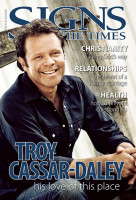During the early 1800s, William Miller, a Baptist lay preacher, became convicted that the second coming of Jesus would soon occur. For several years, he resisted preaching about this conviction, but in 1832, he accepted an invitation to speak at a Baptist worship service in Dresden, New York. The people were so impressed by Miller's exposition of Daniel and Revelation that they invited him to speak every evening that week.
Word spread quickly and Miller never lacked for a pulpit after that.
By late 1844, an estimated 75,000 to 100,000 people, including many ministers, had joined what has come to be known as the “Millerite movement.”
Two of those preachers were Charles Fitch and Josiah Litch.
Litch was the first to become a Millerite, and he became an ardent advocate of the Second Coming. Charles Fitch was one of his converts. In a letter to a friend, Fitch wrote, “When dear Brother Litch named the second advent, I went to the Lord; I read my Bible, and all the works that I could obtain. I possessed myself of all the evidences in the case that I could; and then with fasting and prayer I laid them and myself with my all before the Lord... . Light seemed breaking in upon my mind, ray after ray.”
Fitch and Finney
For a few years, Fitch was associated with Charles G Finney, who was the “Billy Graham” of his day. Finney, a young lawyer, became a Christian in 1821 and he eventually became a Presbyterian minister. By the 1830s, what had begun as village revivals, were impacting urban centres such as New York, Philadelphia, Boston and Rochester.
It's been estimated some 500,000 people were converted as a result of Finney's preaching.
When Finney opened his famous Broadway Tabernacle in New York City in 1836, he chose his friend Charles Fitch to preach the sermon and offer the benedictory prayer. Fitch often spoke of Finney as the “father of modern revivalism.” The two were close spiritual brothers. They were also linked as reformers in an age filled with reform. Both embraced social concerns such as antislavery and temperance.
Finney and Fitch also believed Jesus would return someday. However, a serious disagreement over that teaching put extreme strain on their relationship.
Finney believed Christ would come at the end of the 1000-year period called “the millennium,” while Fitch was equally certain the Second Coming would occur before the millennium. (Signs of the Times adopts Fitch's view.)
Fitch and “the Advent near”
As a minister in Congregational and then Presbyterian parishes, Fitch gave years of close study to the biblical teaching about Christ's second coming.
In March 1838, he read a paper about the Second Coming to his local ministerial association and in December 1841, a magazine called Signs of the Times (a forerunner of today's Signs of the Times but a different magazine) reported that “dear brother” Fitch “has come into the full faith of the Second Advent.”
Next to William Miller himself, Fitch became one of the most prominent ministers in the Millerite movement. In January 1843, he launched his own Millerite periodical with the title, The Second Advent of Christ. This magazine helps us trace his experience as one of the hundreds of ministers in many denominations who focused on Miller's message of Christ's return. By March 1844, a Second Advent paper in New York City, The Midnight Cry, estimated that between 1500 and 2000 lecturers were proclaiming that “the Kingdom of heaven is at hand.”
Methodist ministers—followed by Baptist, Congregational and Presbyterian clergy—were the most prominent heralds of the urgent message of the nearness of Christ's return. Such preachers were not short of Bible verses to sustain their claim that Christ would return personally, visibly, audibly and gloriously. Didn't Jesus liken His return to the brightness of lightning that shines from the east to the west? He also declared that “all the nations of the earth ... will see the Son of Man coming on the clouds of the sky, with power and great glory”
(Matthew 24:26–30). These ministers cherished the apostle Paul's reference to “the blessed hope—the glorious appearing of our great God and Saviour, Jesus Christ” (Titus 2:11–14).
Fitch's spirituality
To study the writings of Charles Fitch is to journey with him into a deepening understanding of the Bible and its saving message. As Fitch wrestled with the significance of Christ's glorious return, he started to see a fresh meaning in the texts that refer to the resurrection.
Jesus promised, “All that are in their graves will hear his voice.” He declared Himself to be “the resurrection and the life.” When the apostle Paul described the events that will occur at the Second Coming, he stated that “the dead in Christ will rise first” (see John 5:28; 11:25; 1 Thessalonians 4:16).
Fitch was especially enthusiastic about Miller's preaching of the second advent of Christ. Like Fitch, for a number of weeks, Miller believed the Scriptures indicated an exact date on which Jesus would return—October 22, 1844. Miller was of course deeply disappointed when the great day of hope turned into a day of bitter disappointment.
Cured forever of date-setting, on November 10, 1844, Miller wrote a letter that was printed in The Midnight Cry the following month: “Brethren,”
he wrote, “hold fast; let no man take your crown. I have fixed my mind upon another time, and here I mean to stand until God gives me more light— and that is Today, TODAY, TODAY, until He comes, and I see Him for whom my soul yearns.”
Unfortunately, several weeks before October 22, Fitch performed several baptisms outdoors in cold weather.
As a result, he contracted pneumonia, and he died on October 14, 1844, just eight days before the anticipated date of Christ's return. Had he lived to read Miller's letter, he would surely have heartily agreed. He might also have quoted what Jesus said, after describing the signs that warn us about the climax of history: “When these things begin to take place, stand up and lift up your heads, because your redemption is drawing near” (Luke 21:28).
In His greatest Advent sermon, Jesus speaks to all of us, saying, “Therefore keep watch, because you do not know on what day your Lord will come” (Matthew 24:42).






